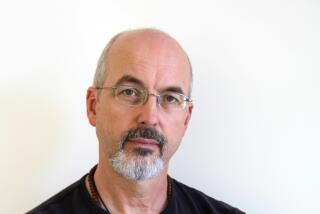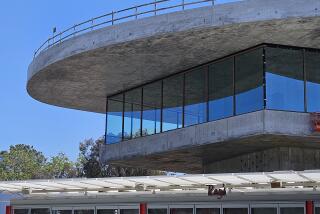ROBERT BATSCHA: The Man Behind TV’s Museum
From the groundbreaking news programs of Edward R. Murrow to the best episodes of “The Young and the Restless,” from “The Dick Van Dyke Show” to “Cheers” and “Quantum Leap,” the Museum of Broadcasting’s annual television festival seeks to bring the best of TV to Los Angeles, much like a film or art festival brings the best of those media.
For seven years, the New York-based museum has brought choice tidbits from its collection to Southern California audiences at the Los Angeles County Museum of Art. This year’s festival, which continues through March 24, features discussions with television names ranging from Danny Thomas to Ted Turner to Norman Lear.
Sharon Bernstein interviewed Robert Batscha, president of the Museum of Broadcasting and host of each evening’s events, about the festival.
Q: Is there an overall theme to the festival?
A: It’s the breadth and depth of television. The key is to show that television over the past 50 years has had an extraordinary collection of programming of real excellence, and really has had a variety of material. What we’re trying to do is take material from the early days to the middle days to now, from situation comedy to drama to variety.
This year, we’re adding two sections, one with (comedian) Stan Freberg on advertising and one on daytime programming, for which we’re featuring “The Young and the Restless.”
Since the theme of the festival is the programming, everything revolves around the showing of programs. But it really is meant to be a festival and a celebration of the creative community. We introduce the people who worked on each program before the screening, then invite them back to the stage afterward for questions.
Q: Why put on a festival of television?
A: Every creative form has festivals. Dance has festivals, music has festivals. We felt that television ought to have a festival that focused on the core of television, the programming that most of the people in the United States watch.
Q: Is there any room in the festival for criticism of television?
A: It happens in the discussion, certainly. But you wouldn’t do a festival of bad programming. The purpose of the museum, and the purpose of any museum, is to show the best. You would never see an exhibit at LACMA or any other museum that said these are the worst paintings of Picasso.
We’re not opposed to criticism, it’s just that there are so few institutions that are looking at what is excellent.
Q: So the idea is to exhibit these programs as you would exhibit paintings?
A: Exactly. You are putting on the walls outstanding examples of creativity.
One of the important roles of a museum is to let people know that there is an author, that there is a producer and there are great performances.
For this year, we’re showing “Wonderful Town” (with Rosalind Russell), a tribute to Edward R. Morrow, “Kiss Me Kate” and a tribute to the very early creativity, the Cahuenga Studio legacy. That was the studio run by Danny Thomas and Sheldon Leonard in the T50s and early T60s. Out of that came an enormous amount of creativity and was also a training ground for many of the people who are doing work in television today, like Jay Sandrich, Carl Reiner, Garry Marshall, Sam Denoff, Bill Persky, Saul Turtletaub.
Q: Why did you decide to include advertising?
A: We felt it would be important to introduce advertising into the festival. In the past, whenever the commercials were included, the programs were very popular.
We are putting together what we hope will be the definitive collection of radio and television commercials.
Q: Stan Freberg, who is hosting the program on advertising, made his name as a political satirist. Is he going to be poking fun at commercials?
A: He has created some of the great commercials of our time, and that’s what he is going to be talking about, as opposed to being satirical about the American commercial system.
Q: Many of the seats at the festival have already been reserved for people in the television industry, and you’ve described the event as a “celebration” of television. Who is the festival really aimed at?
A: It’s for the public, and the public is the larger part of the audience. The purpose of the festival is to broaden the awareness among the public in terms of how exciting television is and how, in many respects, outstanding its programming is, and to put it in a package like the festival, where you see how exciting and creative this medium is. It’s for the industry in that we are interested in doing the festival not only to salute the industry, but to create a venue where the industry can see how much the public appreciates their work.
Q: Besides this festival, what does the museum do? What is it like?
A: The museum is a collection of programming, so what you do is you come into the museum and you go into our library. The programs are catalogued. You select a program you want to watch. You’re assigned a console, and you watch whatever program you’ve chosen.
Q: Who comes to the museum? What do they tend to see?
A: The general public comes in to see programs that they missed. A lot of people come in with their friends to have a good time. People come in to see shows that they missed. A lot of Vietnam veterans come in to see the final episode of “The Fugitive.”
The most requested program is the Beatles on Ed Sullivan.
Then we have a lot of people coming in to do scholarly work. If you’re researching the Second World War, it’s very important to listen to our radio collection, because that’s how the American public heard about the war. If you’re researching Vietnam, you want to watch our collection of TV programming.
Q: Why is the museum in New York but the festival in Los Angeles?
A: The museum was set up by (CBS founder) Bill Paley, and Paley was based in New York.
But when we decided we wanted to do a festival, we decided it should be done in Los Angeles, because television is based there.
More to Read
The biggest entertainment stories
Get our big stories about Hollywood, film, television, music, arts, culture and more right in your inbox as soon as they publish.
You may occasionally receive promotional content from the Los Angeles Times.










